The all-new Lexus UX subcompact crossover debuted today at the Geneva Motor Show with two new engines: The UX 200 and UX 250h. Here’s the full press release with all the details.
- The first-ever Lexus compact luxury crossover
- Bold “Urban Explorer” design
- First Lexus built on the new GA–C global platform
- UX 200 features all-new 2.0-liter engine coupled with Direct Shift Continuously Variable Transmission
- UX 250h combines new gas engine with 4th generation hybrid system
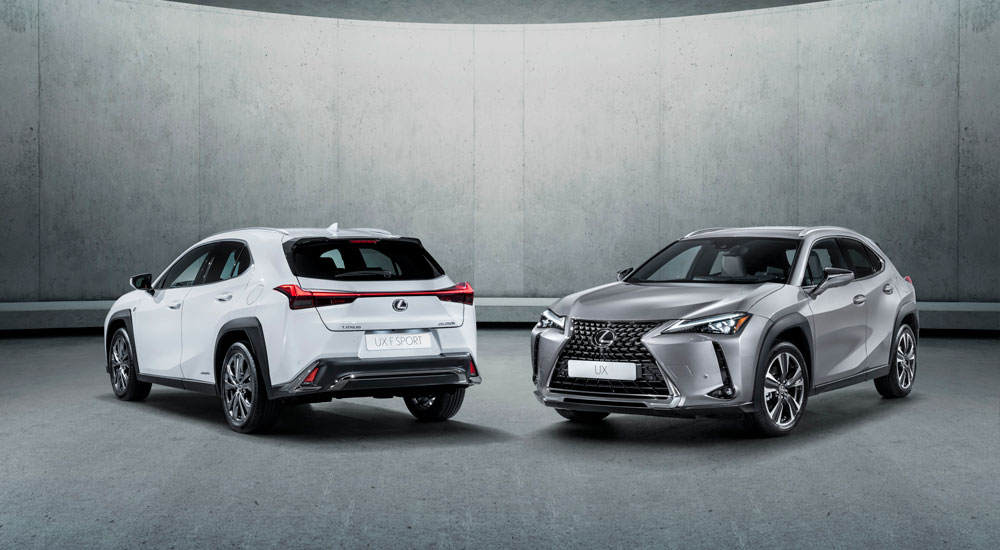
GENEVA, March 6, 2018 – Following recent launches of its stunning new LC flagship coupe, LS flagship sedan and three-row RX luxury utility vehicle, Lexus is opening a new gateway into the brand with the UX, its first-ever compact luxury crossover. Making its world debut at the 2018 Geneva Motor Show, the UX introduces a bold new design, ultra-efficient new powertrains and innovative luxury features.
“The first-ever Lexus UX is designed for the modern urban explorer seeking a fresh, contemporary and dynamic take on luxury driving,” said Chika Kako, executive vice president of Lexus International and chief engineer of the UX. “We designed the UX to appeal to buyers in their 30s who seek not only what is new and exciting, but what is also relevant to their lifestyles.”
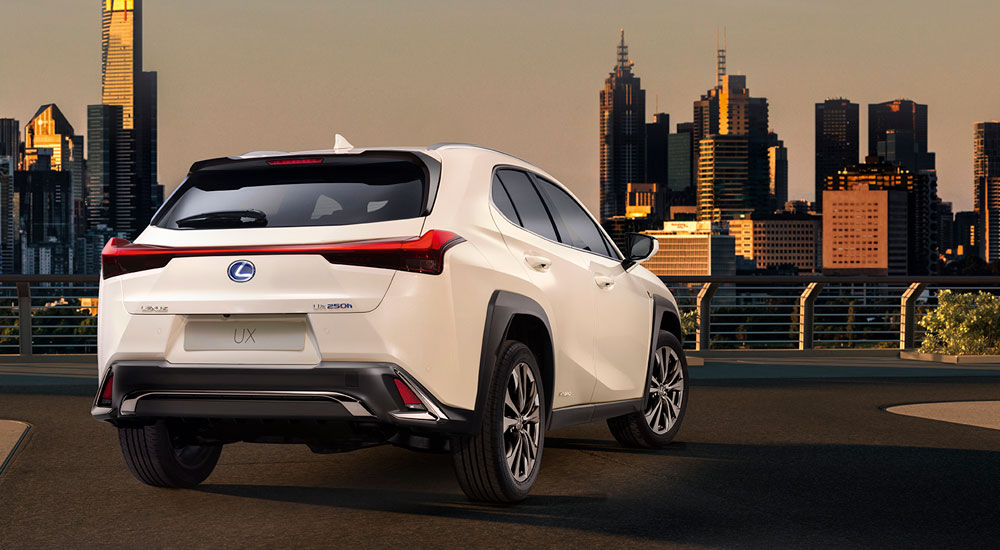
The UX is the first Lexus to use the brand’s GA-C (Global Architecture – Compact) platform. The super-rigid structure and low center of gravity help the UX deliver exemplary handling agility and ride comfort, along with a distinctive driving personality.
The 2019 Lexus UX will be available in two versions: the UX 200 introduces a new 2.0-liter, four-cylinder engine coupled with a new Direct-Shift continuously variable transmission (CVT), while the UX 250h pairs the same 2.0-liter gas engine with a new fourth generation hybrid drive system. New technology that networks with navigation allows the UX 250h to proactively optimize hybrid operation by learning, and adapting to the driver’s routes and driving habits.
DARING DESIGN, URBAN VERSATILITY
The UX makes a bold statement in a segment characterized by conventional SUV themes. The striking design, notable for its crisp, prominent sculpting and dramatically flared front and rear fenders, envelops a cabin that provides a driver-focused cockpit and a roomy, relaxing space for passengers.
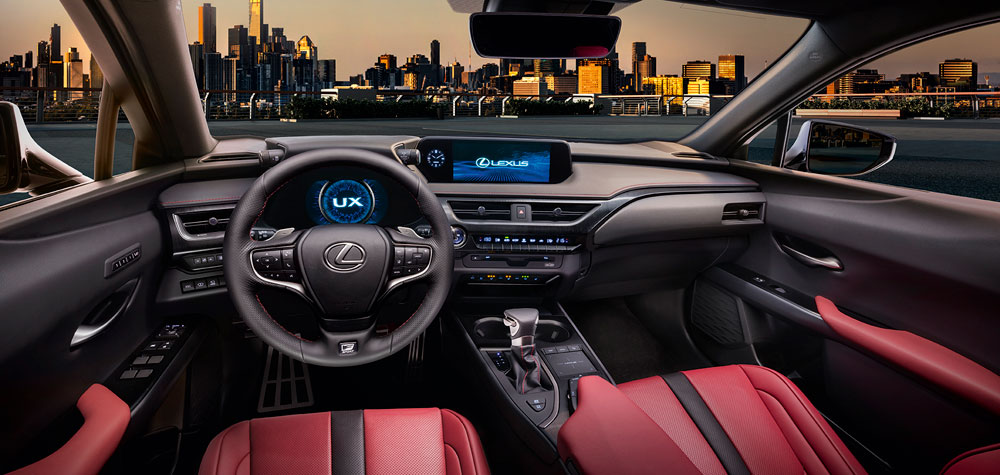
Making urban exploring easier, the vehicle’s proportions allow for easy maneuverability, with a best-in-segment 34-foot turning circle. A 103.9-in. wheelbase contributes to a smooth, stable ride and cabin roominess, while the 177-inch length lets the Lexus UX easily slip into convenient “compact only” parking spaces.
The vehicle’s basic form flows out from the lines of the Lexus spindle grille to envelop the cabin. Sculpted exterior surfaces, including front and rear fender flares, convey strength and security. The UX’s spindle grille uses a new block-shape mesh pattern with individual elements that gradually change in shape as they radiate out from the central Lexus emblem. The grille takes on a compelling three-dimensional appearance that appears to change with the viewing angle. Daytime running lights arranged in an arrowhead motif above the headlights emphasize the Lexus L-shaped lighting signature and highlight the daring front-end design.
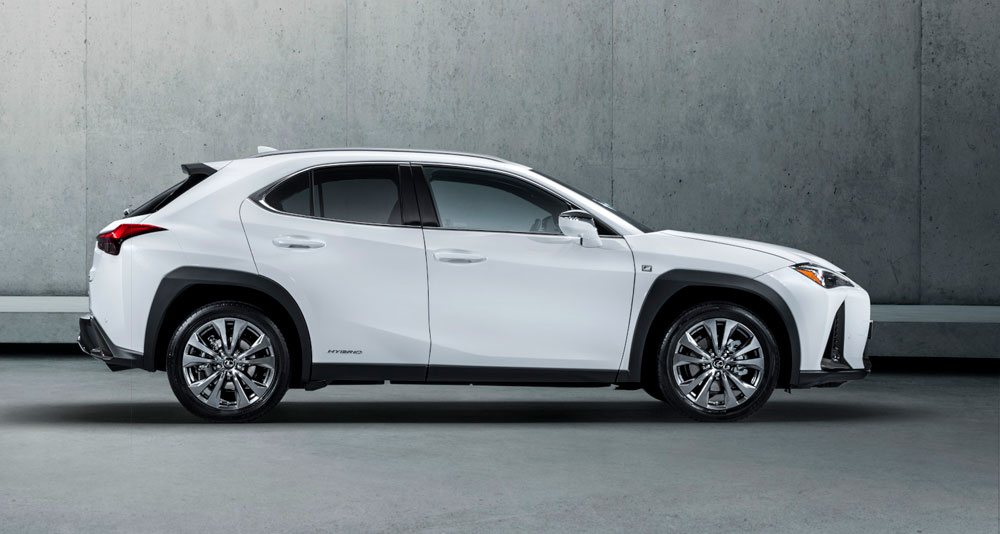
At the rear, an elegantly simple styling treatment contrasts sharply with the flared fenders to emphasize the UX’s dynamic and strong crossover qualities. A new Lexus signature feature, the full-width taillights project a distinctive nighttime signature formed by a sequence of 120 LEDs and tapering toward the center, measuring just 3mm thick at its narrowest point.
Among new 17- and 18-inch aluminum wheel designs created expressly for the UX, the five-spoke 17-inch wheels feature a world-first aerodynamic design. Computer simulations and wind tunnel testing yielded a profile shape for the wheel’s spokes that increases the airflow to cool the disc brakes, without compromising the vehicle’s coefficient of drag (Cd).
INTERIOR DESIGN: A NEW KIND OF LEXUS LUXURY
The interior look and feel of the UX is pure Lexus. From its inception, Lexus has drawn on centuries-old Japanese traditions in craftsmanship and hospitality to infuse its vehicles with a unique sense of contemporary luxury and the UX is no exception.
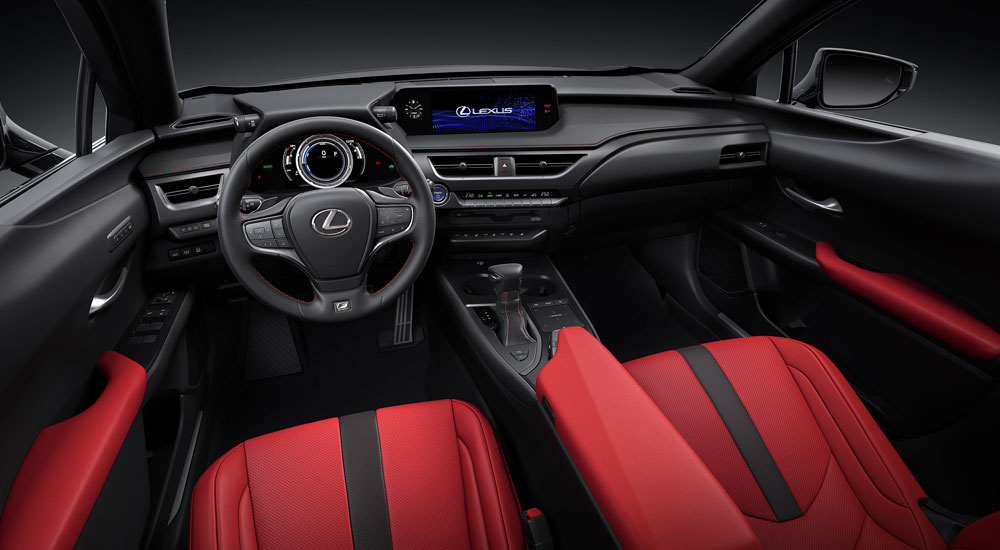
Inspired by a traditional Japanese concept that blurs the boundary between a home’s exterior and interior, designers created a feeling of seamless continuity for the UX. From the driver’s seat, the upper section of the instrument panel appears to extend out beyond the windshield, giving the driver an excellent field of vision and a clear sense of the vehicle’s dimensions. Viewed from outside the vehicle, the hood appears to connect directly to the instrument panel through the windshield.
Entering and exiting the UX is made easier through optimal placing of the hip-point and unique shaping of the seat cushion. The human-centered approach continues behind the steering wheel. The instrument panel’s low, unobtrusive design and slim A-pillar moldings are shaped to improve visibility. The UX gives the driver a commanding view of the road expected from a crossover, yet with a driving position that feels more like that in a sport hatch.
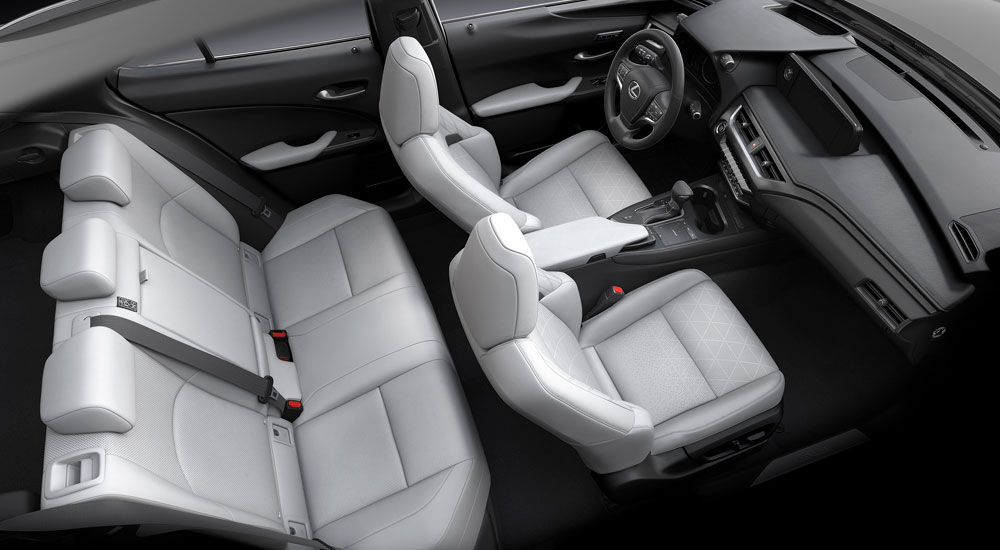
A “seat-in-control” concept focuses operation of all key vehicle functions around the driver’s side of the cabin, and the seatback shape allows the driver to operate the controls while maintaining a comfortable, natural posture. There’s plenty of technology in the Lexus UX, and here again, the human-centered design approach makes it all easily accessible. One example is the integration of audio switches into a palm rest on the center console.
Even with such a strong focus on the driver, the UX cabin creates a relaxing atmosphere for the passengers. Chika Kako, Chief Engineer of the UX, drew on her experience in materials development and time spent working in Europe to help define the interior’s appearance and quality, in particular, applying an uncluttered “less is more” approach.
Luxurious New Finishes
The UX debuts two striking interior finishes that likewise connect to Japanese tradition. One element is an optional leather upholstery inspired by sashiko, a customary Japanese quilting technique that is also used in the making of judo and kendo martial arts uniforms. A perforation pattern derived from mathematical curves and gradations in perfect alignment gives the seats a particularly contemporary appearance.
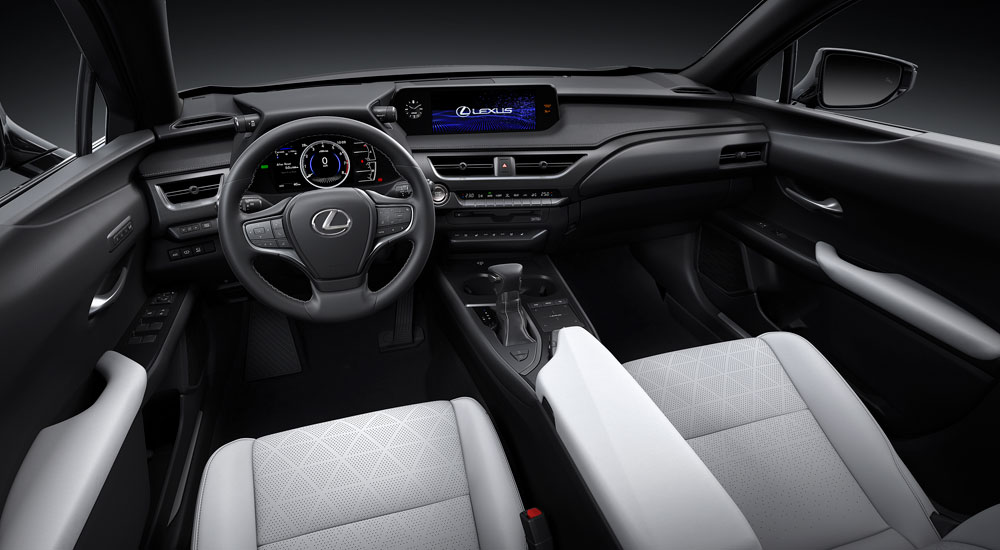
The UX’s sweeping instrument panel and cabin trim offer a choice of two different grain patterns and four colors. In a Lexus first, the UX offers a new trim finish inspired by the grain of Japanese paper, known as washi, familiar in traditional Japanese homes. Created using a slush-molding process and a carefully chosen surface finish, it evokes a calm and warm feeling. A leather grain finish, shared with the Lexus LC coupe and LS sedan, is also available.
IMAGINATIVE TECHNOLOGY
Boldness doesn’t end with the UX’s exterior. Lexus designers created a cabin atmosphere with a depth of quality that will be especially apparent to those buying a premium brand vehicle for the first time.
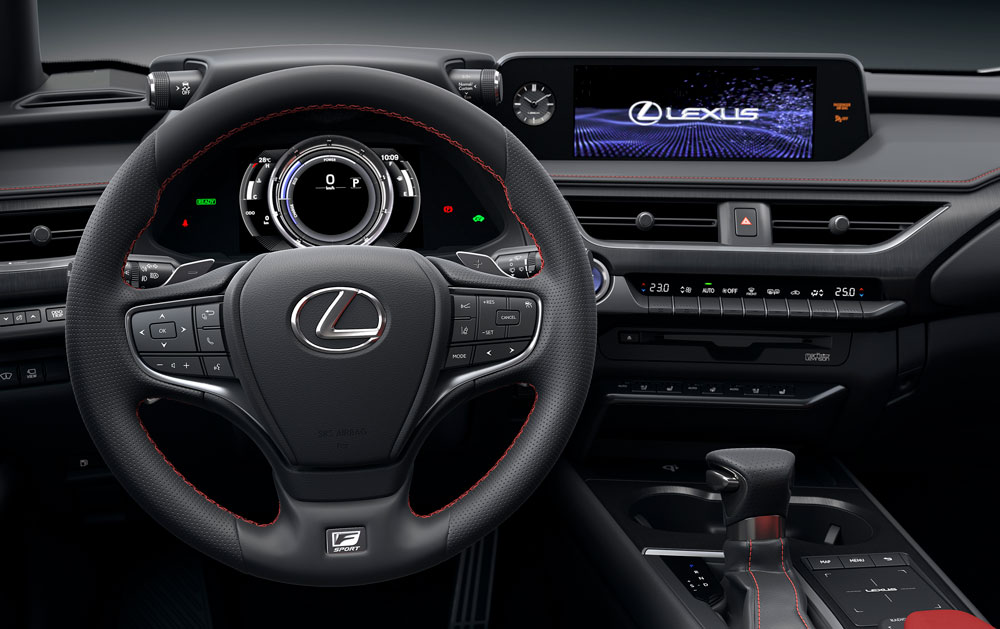
As one example, each of the UX’s air vents uses a new single-knob control for airflow direction and volume while the vents themselves are illuminated using a new wireless system. By combining the two functions in a single control, the vents could be made larger, improving their effectiveness. Each control’s LED light source is wirelessly powered using electromagnetic resonance between two coils vibrating at the same frequency. Using the same design principle as the Lexus LC’s rear combination lamps, the vent LEDs use mirror optics to create the effect of floating lighting depth, even though the reflector element is just 3mm thick.
EXHILARATING PERFORMANCE
Compact and infused with dynamic attitude, the 2019 Lexus UX is engineered to deliver the feeling of “elegant performance.” It’s quick and engaging, yet Lexus-smooth in demeanor.
Central to the vehicle’s responsiveness and comfort, the GA-C platform gives the UX the lowest center of gravity of any vehicle in its class. Engineering that instills high rigidity into the UX includes a high-tensile and ring structure around the rear door and tailgate openings. As in other Lexus vehicles, high-strength adhesives and Laser Screw Welding are used in key locations, enhancing overall rigidity.
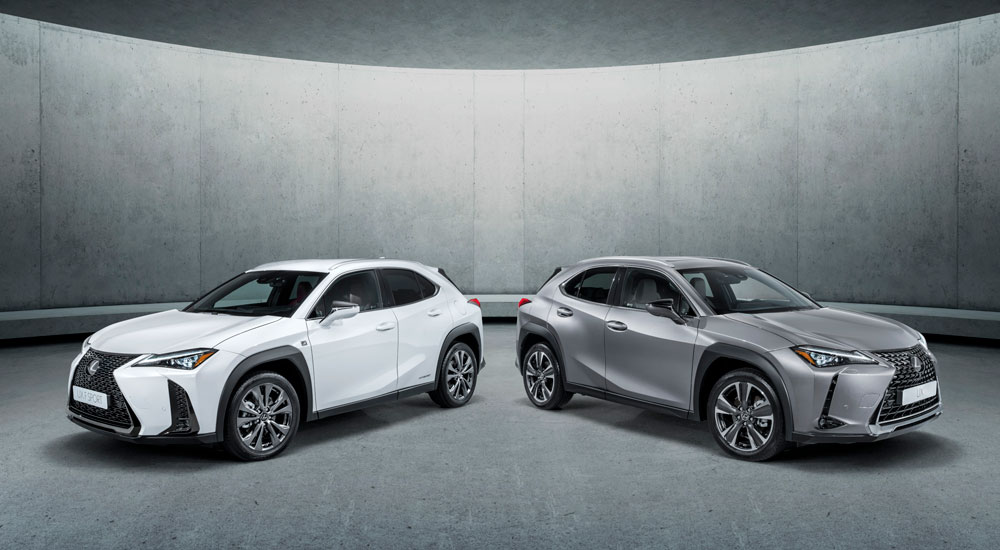
The MacPherson strut front suspension and double wishbone rear suspension system are specially tuned for a combination of urban agility and comfort over well-worn street surfaces. Carefully refined details such as the quality of the damper oil, oil seals and friction control in the shock absorbers have a significant impact on ride quality. An Electric Power Steering system with a new compact and highly rigid column assist supports handling with crisp, immediate response to driver inputs, with excellent steering feel.
UX 200: ULTRA-EFFICIENCY ENGINE AND DIRECT-SHIFT CVT
Engaging performance and high fuel efficiency are also calling cards of the new, 168-horsepower 2.0-liter inline four-cylinder engine in the UX 200. Advanced technologies, including high-speed combustion, multi-hole direct fuel injectors, a continuously variable capacity oil pump, a variable cooling system and VVT-iE intelligent variable valve-timing on the intake side give the engine maximum thermal efficiency of around 40 percent – an exceptional number for a passenger vehicle engine.
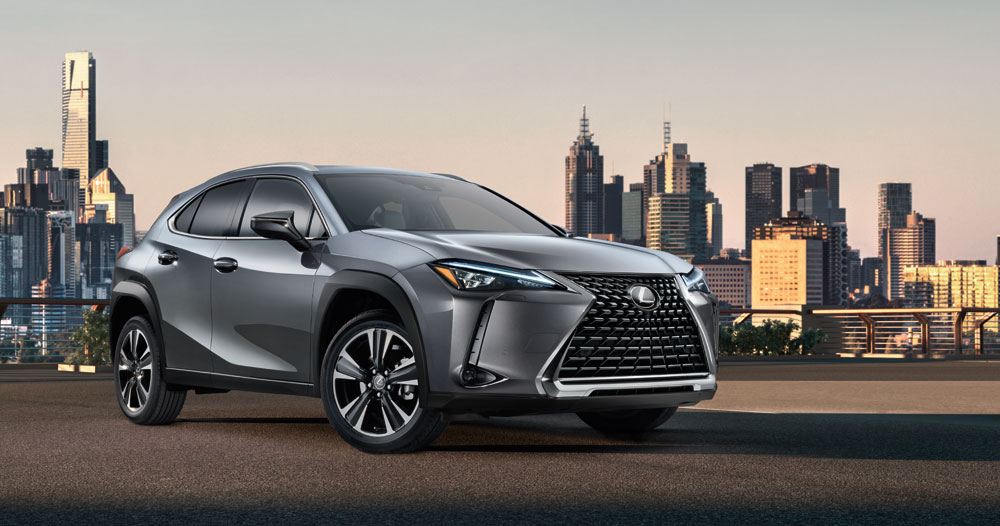
The brand’s first Direct Shift-CVT debuts in the UX 200 to play a key role in driving personality and efficiency. The new transmission combines the smooth, fuel-efficient performance of a conventional continuously variable transmission with a more direct driving feel. A conventional CVT uses two pulleys, connected by a belt, that can change their radius seamlessly, and thus change the effective gear ratio, without any “step” effect. The Lexus Direct Shift-CVT uses an additional gearset for starting off from a stop, giving the UX a quicker, more linear acceleration feeling. Because the gears reduce the need for the CVT’s pulleys and belt mechanism to be used in the low range, more of the CVT’s ratio spread can be dedicated to the higher range, maximizing efficiency.
UX 250H: NEW-GENERATION LEXUS HYBRID DRIVE
Lexus introduced the world’s first luxury hybrid vehicle 15 years ago, and the brand remains the luxury hybrid leader. The 2019 UX 250h underscores that position with a new-generation hybrid powertrain that delivers engaging performance and exemplary fuel efficiency.
The new gasoline engine is notable for its high thermal efficiency, and the new hybrid system has a projected output of 176 total system horsepower. Optimizing the level of electric motor assistance and engine rpm produces a linear acceleration feel without the engine running at high revs. Engine speed is synchronized with vehicle speed to create an immediate and continuous acceleration feel.
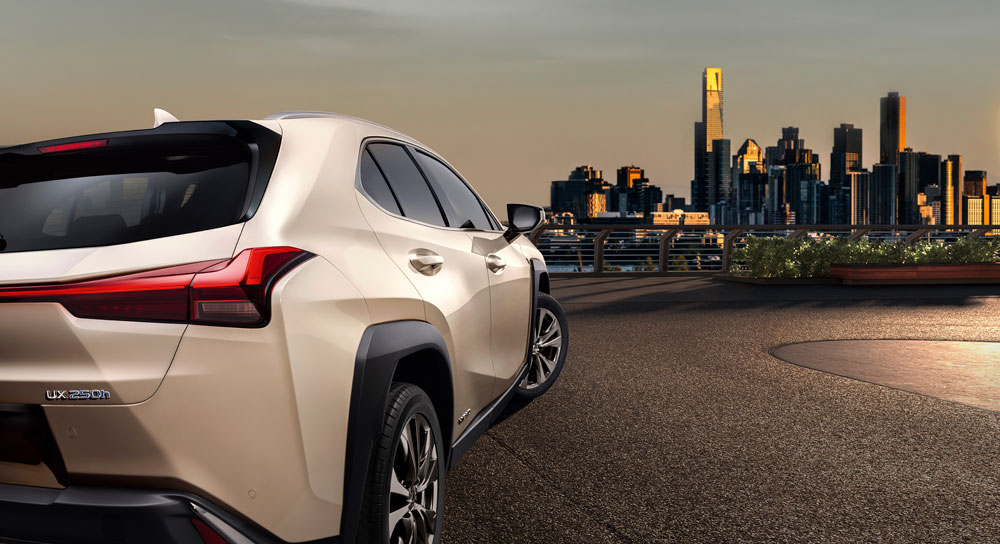
The hybrid system has a compact and lightweight new transaxle and Power Control Unit, designed to minimize power losses through heat and friction. Locating the nickel metal-hydride (NiMH) battery and compact cooling system below the rear seat helps maximize cabin and cargo area space, and their location supports the vehicle’s low center of gravity.
E-Four AWD
The E-Four system gives the UX 250h all-wheel drive capability by using an additional electric motor on the rear axle. Power distribution between the front and rear axles is automatically optimized when accelerating, cornering, or driving on slippery surfaces. When a loss of rear-wheel grip is detected, power directed to the rear is increased to around 80 per cent, at speeds up to 43mph (70km/h), contributing to handling stability.
Predictive Efficient Drive
Some hybrid drivers enjoy using “hypermiling” techniques to maximize fuel efficiency. The Lexus UX 250h introduces new technologies that take hypermiling to new heights. The UX 250h debuts Predictive Efficient Drive, a Lexus-first system that analyzes driving habits and the expected road and traffic conditions to optimize charging and discharging of the hybrid battery. The more the UX 250h is driven, the more data is gathered to help optimize fuel consumption. (The system can be turned off if desired.)
Predictive Deceleration Support technology uses accumulated knowledge about a driver’s behavior to predict when and where the vehicle is likely to slow down or stop. For example, when the UX approaches a location where the driver has slowed or stopped in the past, and the driver releases the accelerator pedal, Predictive Deceleration Support increases regenerative braking, allowing more efficient energy recovery and recharging of the hybrid battery. The system can provide deceleration support up to about 1,000 feet ahead of the vehicle.
Predictive State of Charge (SOC) control for the hybrid battery is a world-first technology that functions on both downhill roads and in congested traffic. Operating when the UX is following guidance from the navigation system, it will predict the route for a distance of up to about six miles (10km) ahead.
SAFETY
The UX, the new gateway to the brand, will offer the Lexus Safety System+. It includes a Pre-Collision System (PCS) that can recognize pedestrians at night. Additionally, PCS radar capability has been extended to enable detection of cyclists during the day – road users who are involved in a high number of traffic accidents. The package available for the UX also includes Lexus Co DRIVE (featuring Lane Tracing Assist and Adaptive Cruise Control), Automatic High Beam/Adaptive High-beam System, and Road Sign Assist.
UX F SPORT
The bold design and attitude of the Lexus UX practically shouts out for the brand’s F SPORT treatment, and it is available for both the UX 200 and UX 250h. Exclusive F SPORT suspension tuning includes specific springs and stabilizer bars, plus rear performance dampers to sharpen handling agility. The F SPORT option can be combined with a UX-tailored version of the high-response Adaptive Variable Suspension (AVS) system, which debuted on the Lexus LC flagship coupe. The system increases damping force to minimize roll when cornering or changing lanes and reduces damping force in straight line driving to preserve ride quality. When AVS is fitted, it is linked to the Sport S+ mode in the vehicle’s Drive Mode Select system.
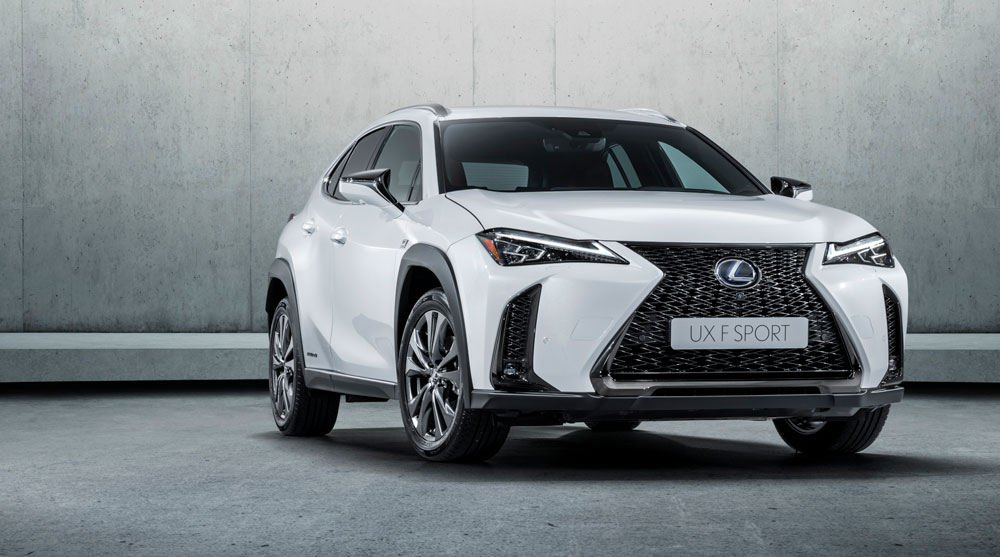
Exclusive exterior features that emphasize a low and wide form give the F SPORT versions a road-hungry look. The mesh version of the spindle grille immediately connects the vehicle to other F SPORT models. Large fog light bezels with L-shaped chrome moldings and detailing that repeats the F-mesh grille pattern amplify visual impact. An exclusive rear bumper design, 18-inch alloy wheels and jet-black trim on the front and rear moldings complete the F SPORT exterior transformation.
F SPORT-exclusive interior features include front sports seats made with a highly supportive integrated foaming technique. An instrument meter with a moving outer ring is an F SPORT signature feature inspired by the Lexus LFA supercar. The package for the UX also adds an F SPORT steering wheel with a dimpled leather covering (also on the shift knob), eight-inch TFT color display, plus sports aluminum pedals and footrest.
The UX F SPORT driving experience can be further enhanced with Active Sound Control (ASC), which generates the aural effect of up- and down-shifts like those of a geared automatic transmission. And additional Sonic Interaction Design (SID) function adjusts the sound the vehicle makes when driving in Sport S+ mode (S+ Sound).
AVAILABILITY
The UX 200 and UX 250h will start production this fall and go on sale in the U.S. in December. Pricing will be announced closer to the on-sale date.

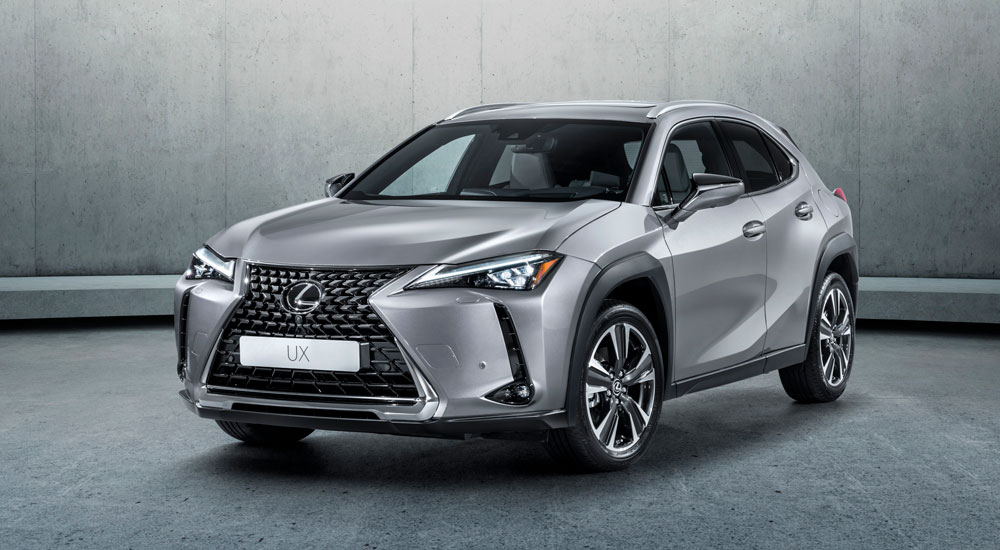
Comments